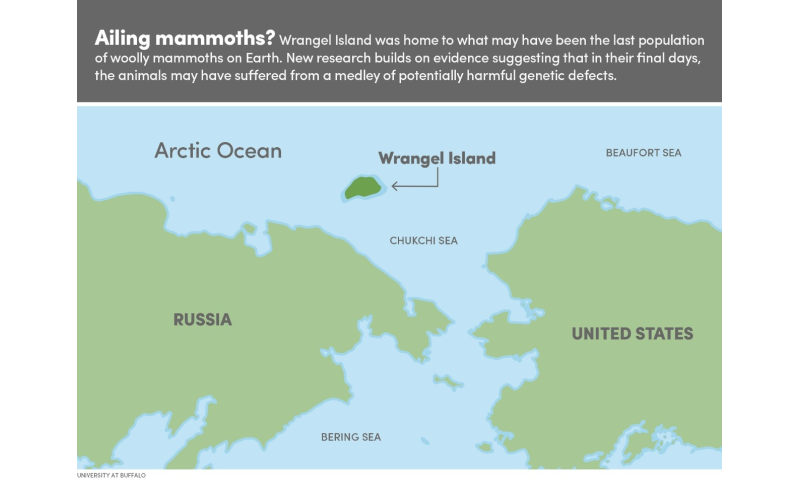Scientists resurrected a Wrangel Island mammoth's mutated genes

Some 4,000 years ago, a tiny population of woolly mammoths died out on Wrangel Island, a remote Arctic refuge off the coast of Siberia.
They may have been the last of their kind anywhere on Earth.
To learn about the plight of these giant creatures and the forces that contributed to their extinction, scientists have resurrected a Wrangel Island mammoth's mutated genes. The goal of the project was to study whether the genes functioned normally. They did not.
The research builds on evidence suggesting that in their final days, the animals suffered from a medley of genetic defects that may have hindered their development, reproduction and their ability to smell.
The problems may have stemmed from rapid population decline, which can lead to interbreeding among distant relatives and low genetic diversity—trends that may damage a species' ability to purge or limit harmful genetic mutations.
"The key innovation of our paper is that we actually resurrect Wrangel Island mammoth genes to test whether their mutations actually were damaging (most mutations don't actually do anything)," says lead author Vincent Lynch, Ph.D., an evolutionary biologist at the University at Buffalo. "Beyond suggesting that the last mammoths were probably an unhealthy population, it's a cautionary tale for living species threatened with extinction: If their populations stay small, they too may accumulate deleterious mutations that can contribute to their extinction."
The study was published on Feb. 7 in the journal Genome Biology and Evolution.
Lynch, an assistant professor of biological sciences in the UB College of Arts and Sciences, joined UB in 2019 and led the project while he was at the University of Chicago. The research was a collaboration between Lynch and scientists at the University of Chicago, Northwestern University, University of Virginia, University of Vienna and Penn State. The first authors were Erin Fry from the University of Chicago and Sun K. Kim from Northwestern University.
To conduct the study, Lynch's team first compared the DNA of a Wrangel Island mammoth to that of three Asian elephants and two more ancient mammoths that lived when mammoth populations were much larger.
The researchers identified a number of genetic mutations unique to the Wrangel Island mammoth. Then, they synthesized the altered genes, inserted that DNA into cells in petri dishes, and tested whether proteins expressed by the genes interacted normally with other genes or molecules.
The scientists did this for genes that are thought or known to be involved in a range of important functions, including neurological development, male fertility, insulin signaling and sense of smell.
In the case of detecting odors, for example, "We know how the genes responsible for our ability to detect scents work," Lynch says. "So we can resurrect the mammoth version, make cells in culture produce the mammoth gene, and then test whether the protein functions normally in cells. If it doesn't—and it didn't—we can infer that it probably means that Wrangel Island mammoths were unable to smell the flowers that they ate."
The research builds on prior work by other scientists, such as a 2017 paper in which a different research team identified potentially detrimental genetic mutations in the Wrangel Island mammoth, estimated to be a part of a population containing only a few hundred members of the species.
"The results are very complementary," Lynch says. "The 2017 study predicts that Wrangel Island mammoths were accumulating damaging mutations. We found something similar and tested those predictions by resurrecting mutated genes in the lab. The take-home message is that the last mammoths may have been pretty sick and unable to smell flowers, so that's just sad.
More information: Erin Fry et al. Functional architecture of deleterious genetic variants in the genome of a Wrangel Island mammoth, Genome Biology and Evolution (2019). DOI: 10.1093/gbe/evz279
No comments:
Post a Comment